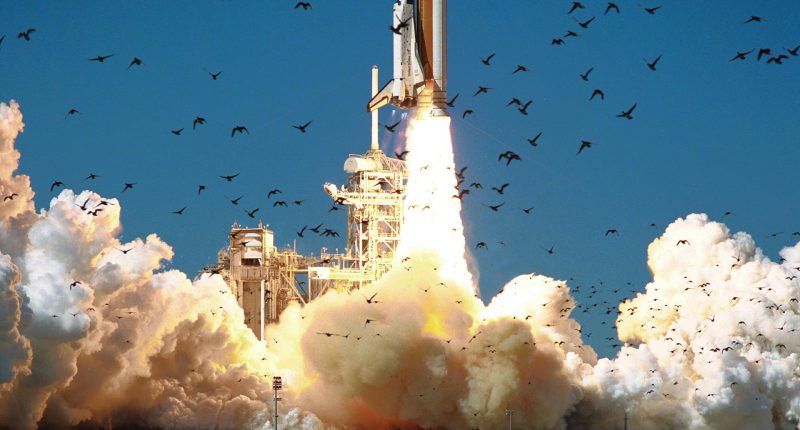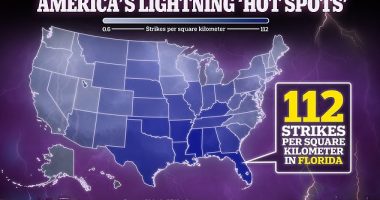NASA has taken home a lot of wins over the decades, but its losses are a stark reminder of the risks astronauts shoulder in the name of science.
Exactly 20 people have died during space missions since 1961 – when it all began – including the 14 who lost their lives the Space Shuttle disasters of 1986 and 2003.
Comprising of 135 missions with 852 fliers, the Space Shuttle Era ran between 1981 and 2011 and helped construct the International Space Station as well as conduct other important science.
With the dawn of space tourism upon us, it can be easy to forget the risks that each flier takes on in their trip to the stars.
And with the current rate of launch success, some overlook that it was always plain sailing.
Soyuz 1: parachute failure
Aboard the Soyuz 1 – the Soviets’ first spacecraft which was hoped to eventually reach the Moon – Vladimir Komarov made history as the first person to enter outer space twice.
READ MORE ON SPACE
It was on his reentry to Earth that Komarov encountered issues with the design of his spacecraft and became the first-ever fatality in spaceflight.
The Soyuz 1 was to orbit Earth and then have a rendezvous with Soyuz 2 before the pair would match their orbital velocities to test docking two spacecraft together.
But one of the solar panels on Soyuz 1 had not deployed and was limiting the power to the spacecraft dramatically – the same fatal flaw suffered by the US’ Peregrine Moon lander.
When it became clear the mission would fail, Komarov began preparing for his return to Earth.
Most read in Tech
And after struggling to puncture Earth’s atmosphere, the parachutes on Soyuz 1 were deployed but did not unfold correctly, making it impossible to slow the spacecraft down.
Soyuz 1 crashed into Earth on April 24, 1967, killing cosmonaut Komarov.
Apollo 1: gas leak
A gas leak aboard the Apollo 1 on January 27, 1967, is what led to the deaths of Virgil Grissom, Edward White and Roger Chaffee – Nasa’s first space-related deaths.
Apollo 1 was set to be the first piloted Apollo flight, but things went horribly wrong during a pre-launch test when a fire swept through the command module.
All crew, including the astronauts, undertook the same procedures they would do on launch day, which was scheduled for 21 February.
Although everyone realised that someday space pilots would die, who would have thought the first tragedy would be on the ground?
James E. Webb, Nasa Administrator
Three hatches of the capsule were closed and pressurised with pure oxygen, slightly higher than atmospheric pressure.
Within seconds, the heat and pressures caused the command module pressure vessel to crack, releasing flames and smoke onto the launch pad.
While the astronauts tried to open the inner hatch from the inside, pad crew valiantly worked to release the outer two hatches.
But the pressurised cabin made it impossible to open, and by the time pad crew were successful, the astronauts had suffered asphyxiation from the toxic fumes.
The burns they received were likely survivable.
Because the test took place with the rocket unfueled, it had been considered non-hazardous and was therefore not reviewed by the relevant safety organisations.
At the time, Nasa’s Administrator James E. Webb said: “We’ve always known that something like this would happen sooner or later, but it’s not going to be permitted to stop the programme.
“Although everyone realised that someday space pilots would die, who would have thought the first tragedy would be on the ground?”
Challenger Space Shuttle
For the 25th Space Shuttle mission, seven people prepared once again for a fresh Challenger flight on January 28, 1986.
What set this mission apart, however, was that one of the crew wasn’t a trained astronaut by trade – and was instead a teacher, plucked from a school in New Hampshire, US.
News of the first non-astronaut in space spread like wildfire, drawing millions of starry-eyed viewers on the day of the launch.
It’s my guess that, at that point, there was awareness on the part at least of the commander and pilot because that was the moment of the explosion.
Richard Truly, Nasa’s associate administrator for spaceflight in 1986
But all seven astronauts died tragically when the Challenger exploded in the sky just 73 seconds into the flight.
This included commander Francis “Dick” Scobee, pilot Michael Smith, mission specialists Ronald McNair; Ellison Onizuka, and Judith Resnik; payload specialist Gregory Jarvis; and teacher Christa McAuliffe.
Just before the blast, pilot Smith could be heard saying “uh-oh” on the intercom in the shuttle’s cabin.
“It’s my guess that, at that point, there was awareness on the part at least of the commander and pilot because that was the moment of the explosion,” Richard Truly, Nasa’s associate administrator for spaceflight said at the time.
The explosion occurred after a leak in one of two Solid Rocket Boosters that ignited the main liquid fuel tank.
As a result, the explosion became “one of the most significant events of the 1980s, as billions around the world saw the accident on television and empathized with any one of the several crewmembers killed,” according to Nasa.
It took nearly two months to recover the remains of all seven astronauts from the bottom of the Atlantic, some 18 miles off the shore of Cape Canaveral, Florida, where they launched.
No one knows the crew’s exact cause of death, be it water impact or depressurisation.
What we do know is that the Challenger crew was conscious for at least 10 seconds after the blast, as at least three emergency breathing packs were switched on.
Columbia Space Shuttle
Nearly 17 years to the day, on February 1, 2003, the Columbia Space Shuttle was due to return for a 17-day science mission.
The team, commander Rick Husband, pilot Willie McCool, mission specialists Kalpana Chawla, Laurel Clark, Michael Anderson, David Brown and payload specialist Ilan Ramon, had been conducting numerous microgravity experiments in orbit.
But upon reentry to Earth’s atmosphere, the Columbia suffered a catastrophic failure due to a breach that occurred during launch.
The breach involved foam falling from the External Tank and striking the Reinforced Carbon Carbon panels on the underside of the left wing.
It meant hot gases were able to penetrate the damaged tile section and melt major structural elements of the wing, which resulted in its eventual collapse.
Just 15 minutes before Columbia and its seven-strong crew were scheduled to touchdown at Kennedy Space Centre, they perished.
The crew knew of their situation for perhaps only a minute before the entire spacecraft tore apart.
It was the 28th flight for Columbia, which became Nasa’s first shuttle to fly in space some two decades earlier.
Debris showered across southeastern Texas all the way to southern Louisiana.
Like the Challenger disaster, the Columbia wreckage was recorded on television.
READ MORE SUN STORIES
Major components and the remains of the crew were recovered the following month.
The Columbia Space Shuttle tragedy is the subject of a new, ‘harrowing’, limited docuseries on BBC.
Find out more about science
Want to know more about the weird and wonderful world of science? From the Moon to the human body, we have you covered…













